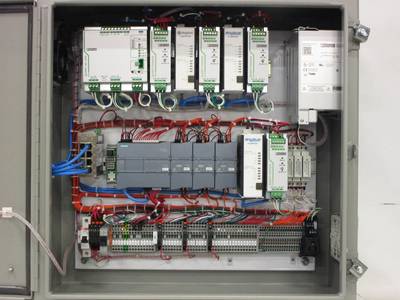Tech File: Automating Ballast Ops When Installing BWMS
Installing ballast water treatment systems to comply with new regulations will require owners to automate ballast operations on board their vessels or barges. Retrofitting ballast water treatment systems generally requires modifications to the existing ballast systems. Many older vessels have remote operated valves, but no automation of the ballast system. EMI has been working with parent company W&O to provide blue water barges with innovative solutions to add automation functionality to their fleet.
When ballast water treatment systems are added to vessels, it requires piping modifications and additional valves to isolate, bypass, and engage ballast water treatment systems. Many of the legacy remote operated valve control systems on board do not have the capability to automate operations, and in many cases, are not expandable to control the newly added valves. Working closely with customers, EMI has designed solutions to replace legacy systems with custom new hardware and software that can automate a variety of modes of operation. Using visually intuitive graphics and onscreen prompts, EMI can provide single touch control to initiate a predefined sequence of turning on/off pumps and opening or closing valves for modes such as Warm up, Ballasting, De-ballasting, Can Flushing and Bypass operations. The sequences are custom tailored to the client’s needs, based on the piping configuration, ballast treatment type and customer procedures on board.
Manufacturers of ballast water treatment systems are often unwilling to relinquish control of the valves in their systems, and unable to take control of valves and pumps outside of their equipment scope of supply due to regulatory constraints, leaving a gap in controls between the legacy valve control system and the new ballast water treatment system.
EMI and W&O work collaboratively with the client, and the BWT equipment manufacturer to determine what valves and piping are needed to install the BWT system, and to develop protocols to provide a ‘handshake’ between the ballast control valve automation system and ballast water treatment. This handshake ensures the two systems are communicating, and that the valves and pumps are correctly configured prior to starting/stopping ballast treatment operations.
The system consists of a Touchscreen and Ballast Control Panel. The touch screen provides the operator an interface using virtual pushbuttons and gauge displays for real-time control and indication of device states throughout the barge. The Valve Control Panel is the core of the system. Power is supplied to the panel from the vessel’s main 115VAC switchboard.
The panel includes a PLC with associated I/O module to receive input signals from the HMI in the control room. The PLC processes the input signals, generates appropriate output signals, sends those signals to the valves, and communicates valve status to the HMI over an Ethernet network. EMI can provide systems with a variety of communication protocols to match vessel and BWT equipment requirements, including Modbus, PROFIBUS, PROFINET, AS-i, and DeviceNet. The panel includes a 24VDC power supply, UPS, and battery to provide power to the system in case of loss of main power.
A set of relays drive remote and local audible outputs in the case of a system fault.












